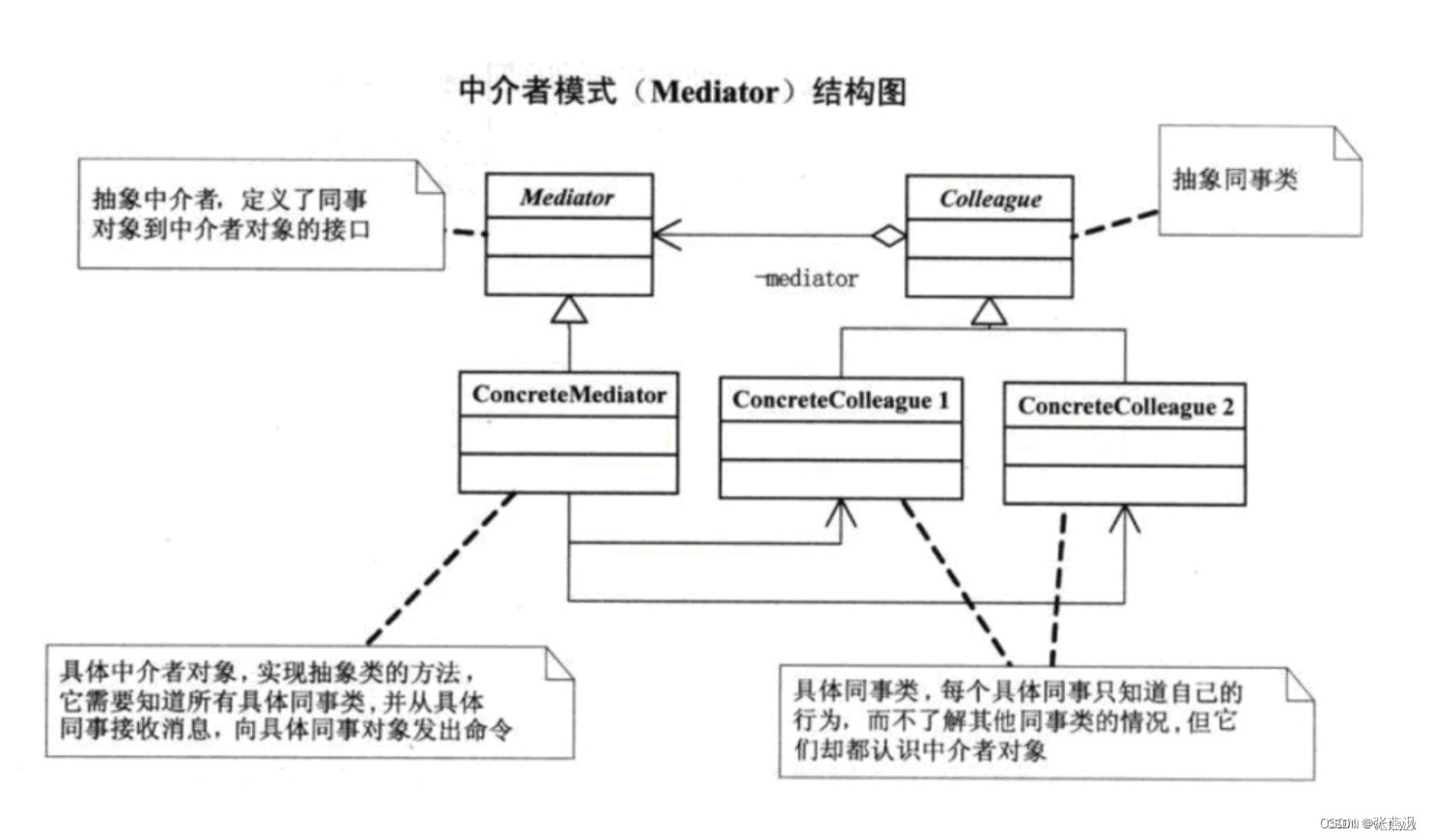设计模式(21)中介者模式
最佳答案 问答题库738位专家为你答疑解惑
一、介绍:
1、定义:中介者模式(Mediator Pattern)是一种行为型设计模式,它通过引入一个中介者对象来降低多个对象之间的耦合度。在中介者模式中,各个对象之间不直接进行通信,而是通过中介者对象进行协调和通信。
2、组成结构:

(1)抽象中介者(Abstract Mediator):定义了中介者对象的接口,用于协调各个同事对象之间的交互。
(2)具体中介者(Concrete Mediator):实现了抽象中介者接口,负责协调各个同事对象的交互,并了解各个同事对象的具体实现。
(3)抽象同事类(Abstract Colleague):定义了同事对象的接口,通常持有一个中介者对象的引用,用于与中介者进行通信。
(4)具体同事类(Concrete Colleague):实现了抽象同事类的接口,实现自身的业务逻辑,并通过中介者对象进行与其他同事对象的通信。
// 抽象中介者
interface Mediator {void send(String message, Colleague colleague);
}// 具体中介者
class ConcreteMediator implements Mediator {private Colleague colleague1;private Colleague colleague2;public void setColleague1(Colleague colleague1) {this.colleague1 = colleague1;}public void setColleague2(Colleague colleague2) {this.colleague2 = colleague2;}@Overridepublic void send(String message, Colleague colleague) {if (colleague == colleague1) {colleague2.receive(message);} else {colleague1.receive(message);}}
}// 抽象同事类
abstract class Colleague {protected Mediator mediator;public Colleague(Mediator mediator) {this.mediator = mediator;}public abstract void send(String message);public abstract void receive(String message);
}// 具体同事类
class ConcreteColleague1 extends Colleague {public ConcreteColleague1(Mediator mediator) {super(mediator);}@Overridepublic void send(String message) {mediator.send(message, this);}@Overridepublic void receive(String message) {System.out.println("ConcreteColleague1 Received: " + message);}
}class ConcreteColleague2 extends Colleague {public ConcreteColleague2(Mediator mediator) {super(mediator);}@Overridepublic void send(String message) {mediator.send(message, this);}@Overridepublic void receive(String message) {System.out.println("ConcreteColleague2 Received: " + message);}
}// 客户端
public static void main(String[] args) {ConcreteMediator mediator = new ConcreteMediator();ConcreteColleague1 colleague1 = new ConcreteColleague1(mediator);ConcreteColleague2 colleague2 = new ConcreteColleague2(mediator);mediator.setColleague1(colleague1);mediator.setColleague2(colleague2);colleague1.send("msg from Colleague1");colleague2.send("msg from Colleague2");}3、优点:
(1)降低耦合度:中介者模式将对象之间的交互集中在中介者对象中,减少了对象之间的直接依赖和耦合度,使系统更加灵活、可扩展和易于维护。
(2)简化对象间的通信:中介者模式通过引入中介者对象,将对象间复杂的相互通信转变为对象与中介者之间的简单交互,简化了对象间的通信逻辑。
(3)集中控制逻辑:中介者模式将对象间的交互逻辑集中在中介者对象中,使得系统的控制逻辑更加清晰明确。通过定义中介者对象来协调对象间的交互,可以更方便地修改和扩展系统的行为。
(4)促进代码重用:中介者模式将公共的交互逻辑封装在中介者对象中,可以被多个对象共享和复用,避免了代码的重复编写,提高了代码的可维护性和可复用性。
4、适用场景:
(1)当一个系统中对象之间存在复杂的相互关系,导致对象间的交互逻辑难以维护和扩展时,可以考虑使用中介者模式来简化交互逻辑。
(2)当一个对象需要对多个对象进行操作或通知时,可以引入中介者模式来集中管理这些对象之间的交互。
(3)当系统中的对象之间存在循环依赖关系,不方便直接进行交互时,可以通过引入中介者对象来解决循环依赖问题。
二、demo:
1、房租中介:三个房东、三个租客。房东类和租客类互相影响,称为同事类。
(1)抽象同事类
import java.util.Objects;/*** 抽象同事类(这里指房东、租客),有用户名称,以及消息发送、接收功能*/
public abstract class Colleague {//租客、房东 都认识中介Mediator mediator;public String userName;public Colleague(String userName, Mediator mediator){this.userName = userName;this.mediator = mediator;}//这里对userName做equals和hashCode,是为了后面可以用contains判断方法@Overridepublic boolean equals(Object o) {if (this == o) return true;if (o == null || getClass() != o.getClass()) return false;Colleague colleague = (Colleague) o;return Objects.equals(userName, colleague.userName);}@Overridepublic int hashCode() {return Objects.hash(userName);}public void sendMsg(String msg){System.out.println("我"+this.userName+"发送消息");}public void receiveMsg(String msg,Colleague fromColleague){}
}
(2)具体同事类,房东和租客
//房东类
public class LandlordColleague extends Colleague{public LandlordColleague(String userName, Mediator mediator) {super(userName,mediator);}//发送消息,需要通知谁 谁可以收到由中介完成@Overridepublic void sendMsg(String msg) {super.sendMsg(msg);mediator.notice(msg,this);}//收到中介发送的消息@Overridepublic void receiveMsg(String msg,Colleague fromColleague) {System.out.println("房东"+this.userName+"收到"+fromColleague.userName+"发送的消息"+msg);}
}
import java.util.List;//租客同事类
public class TenantColleague extends Colleague {public TenantColleague(String userName, Mediator mediator) {super(userName,mediator);}//发送消息,谁可以收到(所有房东)由中介完成@Overridepublic void sendMsg(String msg) {super.sendMsg(msg);mediator.notice(msg,this);}//收到消息@Overridepublic void receiveMsg(String msg,Colleague fromColleague) {System.out.println("租客"+this.userName+"收到"+fromColleague.userName+"发送的消息"+msg);}
}
(3)抽象中介
//抽象中介
public interface Mediator {//通知void notice(String msg,Colleague fromColleague);
}
(4)具体中介
import java.util.ArrayList;
import java.util.List;/*** 房租中介*/
public class RentMediator implements Mediator{//所有租客List<Colleague> tenantColleagues = new ArrayList<>();//所有房东List<Colleague> landlordColleagues = new ArrayList<>();//添加房东void addLandlord(Colleague colleague){this.landlordColleagues.add(colleague);}//添加租客void addTenantColleague(Colleague colleague){this.tenantColleagues.add(colleague);}/*** 通知* 通知所有房东or 租客* @param msg* @param fromColleague*/@Overridepublic void notice(String msg, Colleague fromColleague) {//房东发的,通知所有租客if(landlordColleagues.contains(fromColleague)){for(Colleague colleague : tenantColleagues){colleague.receiveMsg(msg,fromColleague);}}//租客发的,通知所有房东if(tenantColleagues.contains(fromColleague)){for(Colleague colleague : landlordColleagues){colleague.receiveMsg(msg,fromColleague);}}}
}
客户端:
public class Test {public static void main(String args[]){RentMediator rentMediator = new RentMediator();//房东管理LandlordColleague landlordColleague1 = new LandlordColleague("房东1",rentMediator);LandlordColleague landlordColleague2 = new LandlordColleague("房东2",rentMediator);LandlordColleague landlordColleague3 = new LandlordColleague("房东3",rentMediator);rentMediator.addLandlord(landlordColleague1);rentMediator.addLandlord(landlordColleague2);rentMediator.addLandlord(landlordColleague3);//租客管理TenantColleague tenantColleague1 = new TenantColleague("租客1",rentMediator);TenantColleague tenantColleague2 = new TenantColleague("租客2",rentMediator);TenantColleague tenantColleague3 = new TenantColleague("租客3",rentMediator);rentMediator.addTenantColleague(tenantColleague1);rentMediator.addTenantColleague(tenantColleague2);rentMediator.addTenantColleague(tenantColleague3);//tenantColleague2.sendMsg("寻找三室房源");System.out.println("******");landlordColleague3.sendMsg("发布新房源");}
}输出:
我租客2发送消息
房东房东1收到租客2发送的消息寻找三室房源
房东房东2收到租客2发送的消息寻找三室房源
房东房东3收到租客2发送的消息寻找三室房源
******
我房东3发送消息
租客租客1收到房东3发送的消息发布新房源
租客租客2收到房东3发送的消息发布新房源
租客租客3收到房东3发送的消息发布新房源99%的人还看了
相似问题
猜你感兴趣
版权申明
本文"设计模式(21)中介者模式":http://eshow365.cn/6-29455-0.html 内容来自互联网,请自行判断内容的正确性。如有侵权请联系我们,立即删除!
- 上一篇: FIFO 位宽转换
- 下一篇: MySQL主从复制---一主一从配置过程